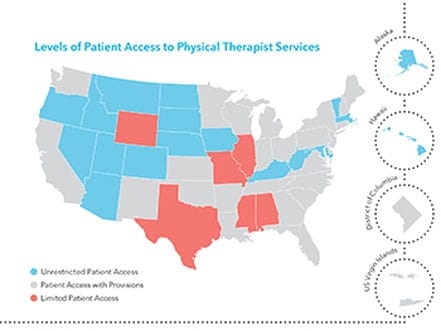Direct access to physical therapy is the ability to go and see a physical therapist (PT) for treatment without needing a prescription or referral from an MD (medical doctor, but you already knew that). It is technically available in all 50 states, according to the American Physical Therapy Association (APTA), but it often comes with a catch.
“Limited patient access” applies to 6 states and is the most restrictive, as the name would suggest. It is defined by the APTA as “access to evaluation, fitness & wellness, and limited only to certain patient populations or under certain circumstances.” Turns out, those circumstances and patient populations happen to be those that have a previous medical diagnosis or already have a physician’s referral. The PT in this case can perform an evaluation, but essentially no treatment can be performed before the patient is seen by a physician. So “limited patient access” is direct access in the sense that you can access physical therapy if you’ve been directly sent by your MD.


Cowboys and Giants fans finally have something to come together over.
“Patient access with provisions” applies to 26 states, Washington DC, and the US Virgin Islands and is exactly what it says. It is defined by the APTA as “access to evaluation & treatment, with some provisions, such as time or visit limits, or a referral requirement for a specific treatment intervention.” In many cases the limitations on time or visits is around 30 days or 10 visits, respectively. It essentially gives the PT a time limit to see if treatment is progressing well or if further medical intervention is indeed necessary.
This is not an inherently bad system since, in some ways, it keeps the therapist vigilant and makes them really evaluate if the selected treatment is effective or not. The pitfalls of this approach arise mainly from two things: communication with the MD’s office and insurance companies. If a patient is nearing that limit and they need a referral from their physician to continue with an effective treatment plan, the patient better hope that both offices are on top of getting that done. Treatment may have to pause if the MD’s office is really busy (like that would ever happen!) and a fax gets lost in the shuffle, or if the PT loses track of the date/visit count and has to request the referral at or after the deadline (I’ve never, ever, done that…).
The other drawback of this is that insurance companies in states where they only recently switched from “limited” access to “provisional” access may be slow to adjust their policies. This often leaves these states in the same boat as limited access states since patients won’t be covered without an MD referral from the get-go.
“Unrestricted patient access” applies to the final 18 states (you know, the cool ones) and is defined by the APTA as having “no restrictions or limitations whatsoever for treatment absent a referral.” This means that patients can come to a PT for treatment off of the street, get an evaluation and treatment, and then be discharged all without necessarily needing to see their physician. The main advantage for the patient, and the PT, with this policy is that it reduces the amount of time the patient needs to wait to get treatment. This is especially nice for relatively simple injuries or aches & pains that are relatively recent and haven’t healed on their own. The main challenge posed by unrestricted direct access mainly falls on the shoulders of the PT. Since they are operating completely autonomously in this scenario, the need to stay vigilant in terms of the effectiveness of treatment, and when to refer out to an MD, is heightened. The therapist needs to be attentive and responsive to what they are doing with their patients to make sure optimal care is delivered. I might know a couple people if you’re looking.
In my view, the limitations on direct access to physical therapy are starting to fall behind the times. This position made more sense in the days before the doctor of physical therapy (DPT) degree was introduced, but makes less now that DPTs are pervasive in the healthcare system. There have been programs to upgrade skills learned at the Master’s level to the Doctorate level since 1992 (shout out to USC!) and an entry-level DPT program since 1993 (shout out to Creighton!). All programs as of 2015 are DPT programs, meaning therapists now are more equipped than ever to tackle the problems presented in the healthcare system head-on. The APTA said it best in 2000 with their Vision 2020 statement (I see what you did there):
“By 2020, physical therapy will be provided by physical therapists who are doctors of physical therapy, recognized by consumers and other health care professionals as the practitioners of choice to whom consumers have direct access for the diagnosis of, interventions for, and prevention of impairments, functional limitations, and disabilities related to movement, function, and health.”
Direct access has been shown to yield better outcomes for patients and reduce the overall cost of treatment for a while now. It’s something that is readily available and unrestricted here in AZ and, hopefully soon, in more states around the country (and DC).

I didn’t forget about you, DC! I did forget about you, Virgin Islands.



